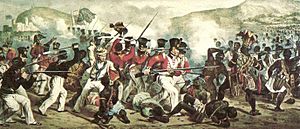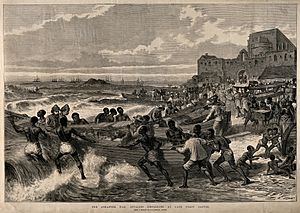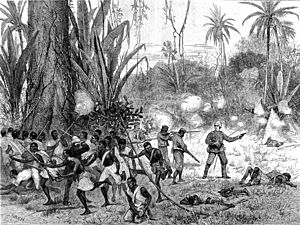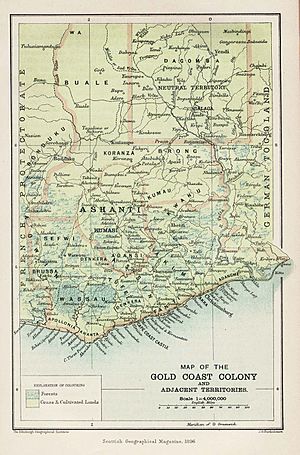Anglo-Ashanti wars facts for kids
Quick facts for kids Anglo-Asante wars |
|||||||
|---|---|---|---|---|---|---|---|
| Part of the British colonisation of Africa | |||||||
 "Defeat of the Ashantees, by the British forces under the command of Coll. Sutherland, July 11th 1824" |
|||||||
|
|||||||
| Belligerents | |||||||
| Commanders and leaders | |||||||
|
|
||||||
| Casualties and losses | |||||||
| ± 1,100 | ± 2,300 | ||||||
The Anglo-Ashanti wars were a series of five big fights. They happened between 1824 and 1900. These wars were between the Ashanti Empire (a powerful kingdom in West Africa) and the British Empire. The British had allies from other African groups.
The main reason for these wars was that the Ashanti wanted to keep control of the coastal areas of what is now Ghana. But the British were protecting groups like the Fante and Ga who lived there. Even though the Ashanti won some battles, the British won the last two wars. This led to the British taking over the Ashanti Empire by 1900.
Contents
Earlier Conflicts: Setting the Stage
Before the main Anglo-Ashanti wars, there were three earlier conflicts. These showed how the Ashanti Empire was growing and clashing with other groups.
- In 1806–07, the British did not want to give back rebels that the Ashanti were chasing.
- In 1811, the Ashanti helped their Ga friends fight against the Fante and their British allies. The Ashanti won early battles but the Fante fought back using surprise attacks. The Ashanti even captured a British fort.
- From 1814–16, the Ashanti defeated another alliance. By 1817, the Ashanti army was very large. The British signed a treaty with them. This treaty said that the Ashanti had control over much of the coast. Later, the British government took over the trading forts from the merchants.
First Anglo-Ashanti War (1823–1831)
By the 1820s, the British decided to help the Fante against attacks from the Ashanti. There were also problems with trade and society that led to fighting.
The war started when some Ashanti kidnapped and killed an African soldier working for the British in 1823. A small British group was led into a trap. Many were killed or hurt, and the British had to retreat. The Ashanti tried to talk peace, but the British governor, Sir Charles MacCarthy, refused. He did not agree that the Ashanti should control Fanti areas.
MacCarthy led his soldiers from Cape Coast. The Ashanti army, with about 10,000 fighters, met MacCarthy's group on January 22, 1824. This was the battle of Nsamankow. The Ashanti soldiers were very disciplined. They marched in perfect order and fired together. They often used nails instead of bullets, which worked well.
MacCarthy made a mistake by splitting his forces. He did not realize he was facing the main Ashanti army. His group of 500 ran out of ammunition and were defeated. Almost all of them were killed. MacCarthy himself was wounded and then killed. His skull was later said to have been used as a drinking cup by Ashanti rulers.
Major Alexander Gordon Laing brought the news of the defeat back to Britain. The Ashanti moved towards the coast. But many of their soldiers got sick, so they had to go back. The new British governor, John Hope Smith, built a new army. This army included many native groups who were enemies of the Ashanti.
In August 1826, the Ashanti planned to attack Accra. The British prepared a strong defense. On August 7, the Ashanti army attacked. The battle was very fierce. The British used new weapons called Congreve rockets. These rockets were very loud and caused serious injuries. The Ashanti were shocked and fled, leaving many casualties. In 1831, a treaty was signed. It set the Pra River as the border between the two sides.
Second Anglo-Ashanti War (1863–1864)
The second war happened between 1863 and 1864. A large Ashanti force crossed the Pra River looking for someone. British, African, and Indian soldiers fought back. But neither side truly won. Many soldiers on both sides got sick and died from illness, more than from fighting. The war ended in 1864 with no clear winner.
Third Anglo-Ashanti War (1873–1874)
This war is also called the "First Ashanti Expedition." It lasted from 1873 to 1875. In 1869, some missionaries had been taken to Kumasi and were still held there in 1873.
The British Gold Coast was officially set up in 1867. In 1872, Britain bought the Dutch Gold Coast from the Dutch. This included Elmina, which the Ashanti claimed as their own. The Ashanti then invaded this new British area.
General Garnet Wolseley was sent to fight the Ashanti. He had 2,500 British soldiers and thousands of West Indian and African troops. The war was reported by newspaper writers like Henry Morton Stanley.
Building a Road to Kumasi
Wolseley arrived in the Gold Coast in August 1873. He planned for his troops to arrive in January 1874. A team of Royal Engineers landed in September 1873. Their job was to build a road from Cape Coast Castle to Kumasi, which was about 160 kilometers away. The road needed to be wide enough for troops to move easily.
They built fortified camps every 10 kilometers. These camps had huts inside strong fences. They also built 237 bridges over streams. A major bridge was built over the 63-meter-wide River Prah. Workers were hired locally, but many got sick. Even so, the road was built. By January 24, 1874, a telegraph line reached Prahsue.
The first troops arrived in late December 1873. They started marching along the new road in January 1874. The troops included soldiers from famous British regiments. By January 29, they were close to Ashanti outposts, and small fights began.
The Battle for Kumasi
The Battle of Amoaful was fought on January 31. The British soldiers, led by the Black Watch regiment, charged with bayonets. The Ashanti were surprised and fled. The British then moved towards Kumasi.
There was another small battle two days later, but the way to Kumasi was open. The British had three killed and 165 wounded Europeans. The Ashanti capital, Kumasi, was empty when the British arrived on February 4. The British blew up the royal palace, leaving Kumasi in ruins. The British were amazed by the palace's size and its many books in different languages.
The Ashanti signed the Treaty of Fomena in July 1874 to end the war. In the treaty, the Ashanti King Kofi Karikari promised to pay 50,000 ounces of gold to the British. The treaty also said that human sacrifice must stop. It allowed free trade between Ashanti and British forts. It also said the road from Kumasi to the Pra River must always be open. Wolseley finished the campaign quickly and left before the unhealthy rainy season.

Wolseley was praised and given many honors. The British lost 18 soldiers in combat and 55 to disease. Many British accounts praised the Ashanti's fighting skills at Amoaful. They especially noted the clever tactics of their commander, Amankwatia.
This campaign was also the first time a steam-powered engine was used in war. It helped move heavy loads and cut wood.
Fourth Anglo-Ashanti War (1895–1896)
The Fourth Anglo-Ashanti War was short, lasting from December 1895 to February 1896. The British wanted the Ashanti to become a British protectorate, but the Ashanti refused. The British also wanted to have a British official living in Kumasi. The Ashanti King Prempeh I did not want to give up his power.
The British wanted to stop French and German forces from taking over Ashanti land, which had gold. So, they decided to conquer the Ashanti. The Ashanti sent a group to London to offer trade deals and to accept British rule. But the British had already decided to use their army. The Ashanti group returned just days before British troops marched into Kumasi.
Colonel Sir Francis Scott led the main British force. They arrived in Kumasi in January 1896. Major Robert Baden-Powell led a group of local tribes. King Prempeh I told the Ashanti not to fight. However, many British soldiers got sick.
Governor William Maxwell arrived in Kumasi. King Prempeh I could not pay the 50,000 ounces of gold demanded by the British. So, he was arrested and removed from power. He was forced to sign a treaty and was sent away to the Seychelles islands with other Ashanti leaders.
Baden-Powell wrote about the reasons for the war. He believed it was to stop human sacrifice and slave trading. He also wanted to bring peace and protect trade. He thought that if a smaller force had been sent, there would have been more fighting. Eleven years later, Baden-Powell started the Boy Scouts. Later, after Prempeh I returned home, he became the Chief Scout of Ashanti.
The British force left Kumasi on January 22, 1896. They reached the coast two weeks later. No shots were fired, but 18 Europeans died from sickness. About half of the troops were sick. Among the dead was Queen Victoria's son-in-law, Prince Henry of Battenberg. He got sick before reaching Kumasi and died on a ship returning to England. In 1897, Ashanti territory officially became a British protectorate.
Fifth War: "War of the Golden Stool" (1900)
A railway to Kumasi was started in 1898, but it was not finished when another war broke out. The railway was completed in 1903.
This war is also known as the "Third Ashanti Expedition." On March 25, 1900, the British representative, Sir Frederick Mitchell Hodgson, made a big mistake. He insisted on sitting on the Golden Stool. He did not understand that it was the royal throne and very sacred to the Ashanti people. He even ordered a search for it. The Ashanti were very angry and attacked the soldiers looking for the stool.
The British retreated to a small fort. It was 50 yards square with 12-foot high stone walls. Inside were 8 Europeans, many mixed-race colonial officials, and 500 Nigerian soldiers. They had six small cannons and four Maxim guns. The British held several high-ranking Ashanti leaders in the fort. The fort was surrounded, and the telegraph wires were cut.
A rescue group of 700 soldiers arrived in June. But many sick people in the fort could not be moved. The healthier people, including Hodgson and his wife, escaped. They met the rescue group and managed to avoid 12,000 Ashanti warriors. They made it back to the coast.
On July 14, a second rescue force of 1,000 soldiers reached Kumasi. They had fought several battles along the way. They relieved the fort on July 15, just when the people inside had only a few days of supplies left. The remaining Ashanti leaders who had not been sent away led the attacks against the British. But they were defeated.
Yaa Asantewaa, the Queen-Mother of Ejisu, led the rebellion. She, King Prempeh I, and other Ashanti leaders were also sent to the Seychelles. The Ashanti lands became part of the Gold Coast colony on January 1, 1902. This happened with the promise that the Golden Stool would not be disrespected by British or other non-Akan foreigners. The Ashanti felt they had won because their sacred stool was not captured.
The British and their allies lost 1,070 people in total. The Ashanti lost about 2,000 people. The sacred Golden Stool, which is on the Ashanti flag, had been hidden very well. Road workers found it by accident in 1920. King Prempeh I returned from exile in 1924. He traveled to Kumasi by a special train.
Awards
Four Victoria Cross awards were given for bravery in the 1873–74 war. Two more were given for the 1900 campaign.
An Ashanti Medal was created for those who fought in the War of the Golden Stool (March – September 1900). It was given as a silver or bronze medal.
Footnote
After the 1896 Expedition, King Prempeh was sent away to the Seychelles. Eleven years later, Baden-Powell started the Boy Scout Movement. King Prempeh was later allowed to return home to Ashanti. He then became the Patron of Ashanti Scouts.
See Also
- List of rulers of Asante
- History of Ghana
- African military systems after 1800
Images for kids
-
Burning of Kumasi depicted by Henry Morton Stanley







